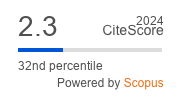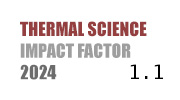THERMAL SCIENCE
International Scientific Journal
NUMERICAL STUDY ON BUBBLE MERGER IN A HEATED SYMMETRIC MICROFLUIDIC T-JUNCTION
ABSTRACT
In this work, the bubble merger process in a heated symmetric micro-fluidic T-junction is numerically studied with the variations of heat flux and seed bubble volume. Detailed bubble behaviors and phase change heat transfer characteristics are revealed. Results show that the bubble experiences slipping and colliding merger regimes at small and large seed bubble volumes, respectively. The bubble grows faster at large heat flux and seed bubble volume. Obvious peak in evaporation rate during the bubble merger can be seen. The bubble behaviors significantly affect the phase change heat transfer. The asymmetry of bubble behaviors under slipping merger regime leads to the heat transfer difference between two main channel walls. Besides, the squeezing effect during bubble merger could promote the heat transfer. Generally, the heat transfer enhancement becomes stronger as the heat flux and seed bubble volume are increased. The present study’s findings could improve the understanding of bubble behaviors and transport details in micro-fluidic T-junction structures.
KEYWORDS
PAPER SUBMITTED: 2024-10-04
PAPER REVISED: 2024-12-12
PAPER ACCEPTED: 2024-12-12
PUBLISHED ONLINE: 2025-02-16
THERMAL SCIENCE YEAR
2025, VOLUME
29, ISSUE
Issue 3, PAGES [2357 - 2368]
- Ma, X., et al., Flow Boiling Frictional Pressure Drop Inside Micro/Mini-Channels: A New General Model and Experimental Investigation, Applied Thermal Engineering, 247 (2024), 123111
- Anandan, S., Ramalingam, V., Thermal Management of Electronics: A Review of Literature, Thermal Science, 12 (2008), 2, pp. 5-26
- Tang, J., et al., Enhanced Heat Transfer Coefficient of Flow Boiling in Micro-Channels through Expansion Areas, International Journal of Thermal Sciences, 177 (2022), 107573
- Asim, M., et al., Flow Boiling Heat Transfer Characteristics of Low Global Warming Potential Refrigerants in A Vertical Mini-Channel, Thermal Science, 26 (2022), 1A, pp. 63-76
- Chen, J., et al., Numerical Investigation on Saturated Boiling Flow and Heat Transfer of Mixture Refrigerant in A Vertical Rectangular Mini-Channel, Thermal Science, 22 (2018), 2, pp. 617-627
- Liu, Y., et al., The Suppression Effect of Easy-to-Activate Nucleation Sites on the Critical Heat Flux in Pool Boiling, International Journal of Thermal Sciences, 129 (2018), July, pp. 231-237
- Zhang, Y., et al., The Effect of Fluctuating Pressure Gradient on the Coalescence of Taylor Bubble, Canadian Journal of Physics, 99 (2021), 7, pp. 501-512
- Shaw, D. B., Deike, L., Surface Bubble Coalescence, Journal of Fluid Mechanics, 915 (2021), A105
- Cui, P., et al., Experimental Study on Interaction and Coalescence of Synchronized Multiple Bubbles, Physics of Fluids, 28 (2016), 1, 012103
- Liu, J., et al., Bubble Coalescence during Pool Boiling with Different Surface Characteristics, Heat Transfer Engineering, 45 (2024), 4-5, pp. 360-380
- Mondal, K., Bhattacharya, A., Numerical Modelling of Adjacent Bubble Interactions under the Influence of Induced Vibrations in Liquid Pool Using Lattice Boltzmann Method (LBM), Journal of Applied Physics, 130 (2021), 22, 224701
- Zhao, Z., et al., Investigation of Bubbles Interaction and Coalescence Boiling in The Boiling Heat Transfer Process, Thermal Science, 23 (2019), 5A, pp. 2605-2611
- Lu, Q., et al., Visual Investigation on the Coalescence Process and the Thermal-Hydraulic Characteristics of The Two-Phase Interface Morphology in Narrow Vertical Channel, International Journal of Heat and Mass Transfer, 115 (2017), Part B, pp. 537-550
- Pattamatta, A., et al., A Parametric Study on Phase Change Heat Transfer Due to Taylor-Bubble Coalescence in A Square Minichannel, International Journal of Heat and Mass Transfer, 76 (2014), Sept., pp. 16-32
- Liu, Q., et al., Numerical Study of the Interactions and Merge of Multiple Bubbles during Convective Boiling in Micro-Channels, International Communications in Heat and Mass Transfer, 80 (2017), Jan., pp. 10-17
- Bhuva, V. J., et al., Effect of Bubble Coalescence on Two-Phase Flow Boiling Heat Transfer in Raccoon Micro-Channel - A Numerical Study, International Journal of Heat and Mass Transfer, 182 (2022), 121943
- Li, W., et al., Numerical Investigation on Bubble Growth and Merger in Micro-Channel Flow Boiling With Self-Rewetting Fluid, Journal of Heat Transfer, 143 (2021), 6, pp. 1-10
- Zhang, Z., et al., The Bubble Merger in Rectangular Micro-Channels During Boiling Processes Based on Conjugate Heat Transfer, Applied Thermal Engineering, 247 (2024), 123093
- Zhang, Z., et al., The Bubble Breakup Process and Behavior in T-Type Micro-Channels, Physics of Fluids, 35 (2023), 1, 013319
- Wang, X., et al., Dynamics of Bubble Breakup with Partly Obstruction in a Micro-Fluidic T-Junction, Chemical Engineering Science, 132 (2015), Aug., pp. 128-138
- Sheng, L., et al., Taylor Bubble Generation Rules in Liquids with a Higher Viscosity in a T-Junction Micro-Channel, Industrial & Engineering Chemistry Research, 61 (2022), 6, pp. 2623-2632
- Yang, L., et al., Experimental Study Of Microbubble Coalescence In A T-Junction Micro-Fluidic Device, Micro-Fluidics and Nanofluidics, 12 (2011), 5, pp. 715-722
- Wu, Y., et al., Bubble Coalescence at a Micro-Fluidic T-Junction Convergence: From Colliding to Squeezing, Micro-fluidics and Nanofluidics, 16 (2013), 1-2, pp. 275-286
- Zhang, J., et al., Numerical Investigation of Heat Transfer and Pressure Drop Characteristics of Flow Boiling in Manifold Micro-Channels with a Simple Multi-Phase Model, International Journal of Heat and Mass Transfer, 211 (2023), 124197
- Wang, Y., et al., Thermal Management of Electronic Components Based on Hierarchical Micro-Channels and Nanofluids, Thermal Science and Engineering Progress, 42 (2023), 101910
- Zong, L., et al., Numerical Study of Seed Bubble-Triggered Evaporation Heat Transfer in a Single Microtube, Micro-Fluidics and Nanofluidics, 16 (2013), May, pp. 347-360
- ***, NIST, NIST Chemistry Web Book, doi.org/10.18434/T4D303, 2018
- Bai, Y., et al., Bubby Behavior and Heat Transfer Characteristics of Bionic Micro-Channels in The Subcooled Flow Boiling Process, Numerical Heat Transfer - Part A: Applications, On-line first, doi.org/10.80/10407782.2024.2326669, 2024
- Dong, F., et al., A Novel Interphase Mass Transfer Model Toward the VoF Simulation of Subcooled Flow Boiling, Numerical Heat Transfer - Part A: Applications, 76 (2019), 4, pp. 220-231
- Brackbill., J. U., et al., A continuum method for modelling surface tension, Journal of Computational Physics, 100 (1992), 2, pp. 335-354
- Pan, Z., et al., Spurious Current Suppression in VOF-CSF Simulation of Slug Flow through Small Channels, Numerical Heat Transfer - Part A: Applications, 67 (2014), 1, pp. 1-12
- Pan, Z., et al., A Saturated-Interface-Volume Phase Change Model for Simulating Flow Boiling, International Journal of Heat and Mass Transfer, 93 (2016), Feb., pp. 945-956
- Magnini, M., Matar, O. K., Numerical Study of the Impact of the Channel Shape on Micro-Channel Boiling Heat Transfer, International Journal of Heat and Mass Transfer, 150 (2020), 119322

